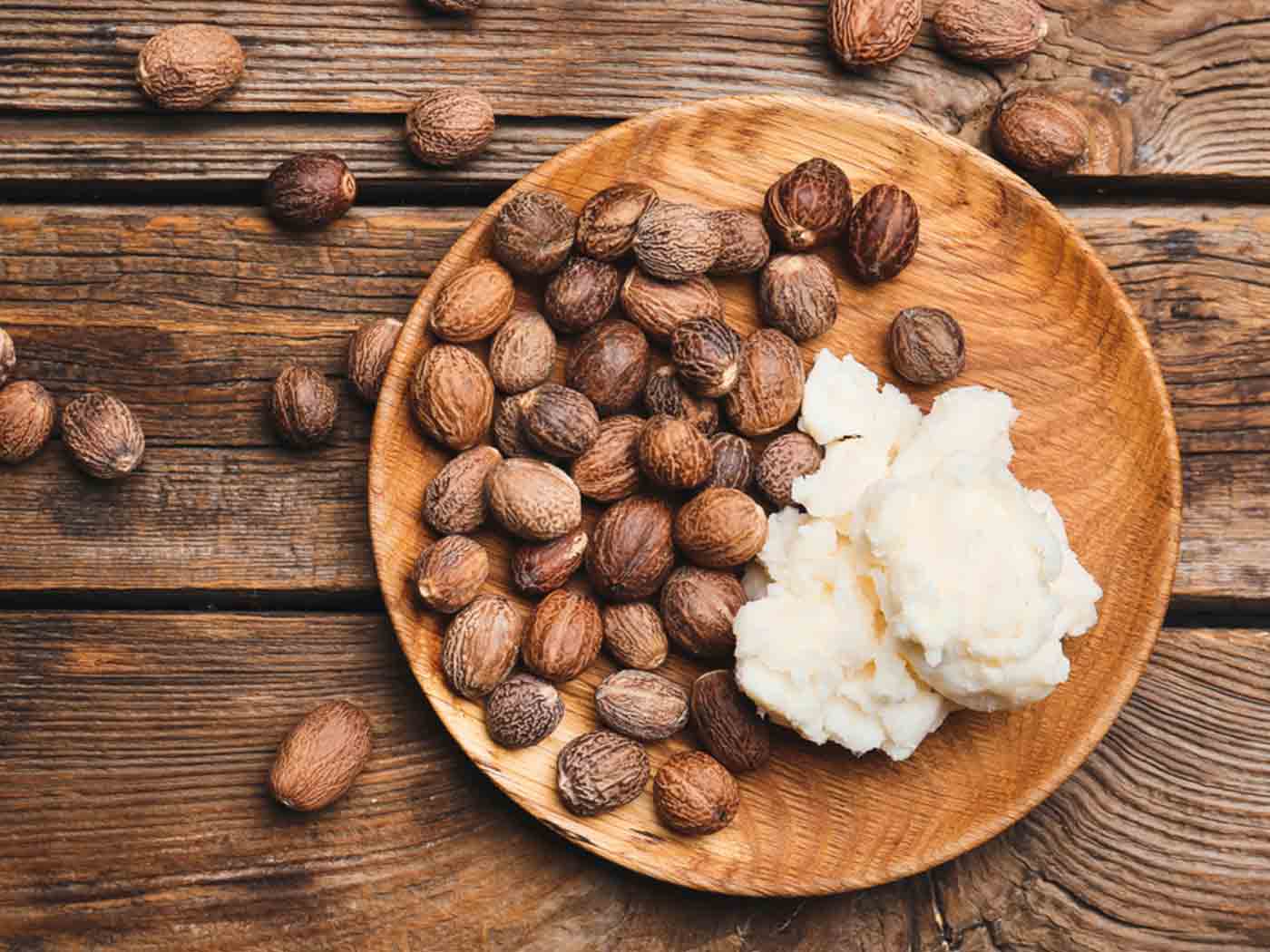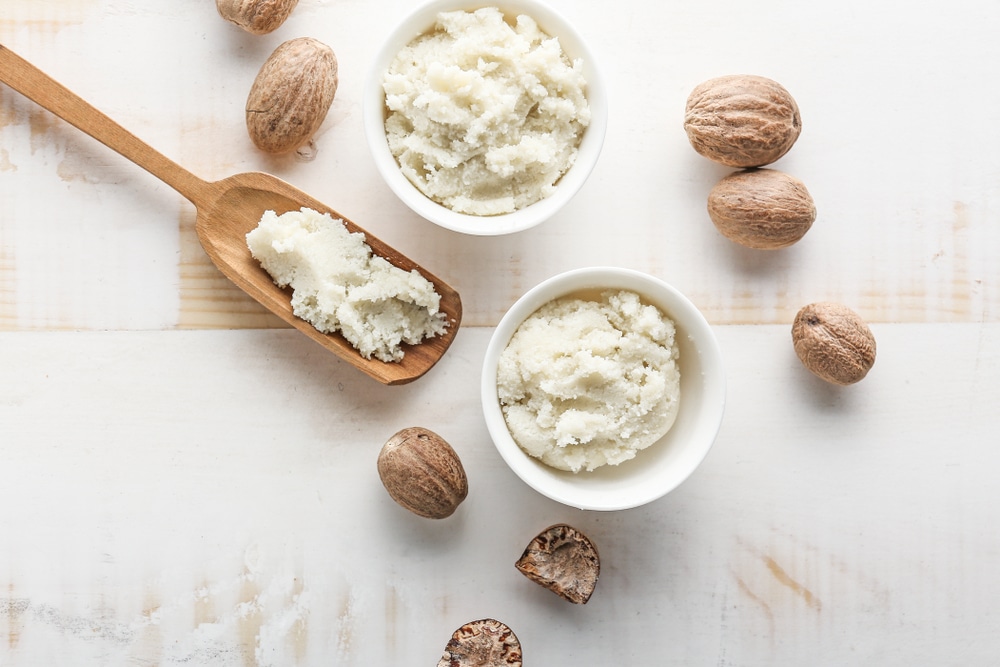
Shea butter is popular in the world of skincare as the buttery moisturizer. And because of its rich, nourishing, and versatile properties, it is the go-to for hydrating dry skin.
But just like other skincare ingredients, it comes with some concerns. Does shea butter clog pores? What are the side effects of shea butter on the face? Will shea butter cause acne? Or is shea butter good for acne?
This article will explore what shea butter is and how you can use it effectively in your skincare routines.
What is Shea Butter?

Shea butter is a fat that comes from the nuts of the Vitellaria paradoxa — or the shea tree. The nuts are boiled, so the shell comes off more easily. The heating process leaves only oily kernels rich in fats, which is the shea butter itself. African women have used it as a beauty secret for hundreds of years.
Raw shea butter is full of vitamins A and E, which makes it an effective moisturizer for any skin type. It can help heal cracked, dry, and irritated skin.
Understanding Comedogenic Ratings
The comedogenic scale ranks how likely it is for certain ingredients to clog the pores. Ingredients like oils and butters are usually ranked according to this scale.
In general, if you're prone to acne breakouts and blackheads, it's a good idea to avoid highly comedogenic oils. On the other hand, people with drier skin might need a soothing oil that lies toward the middle of the comedogenic scale.
The scale uses a 0-5 numbering system:
- 0: Will not clog the pores at all.
- 1: Very low chance of clogging pores
- 2: Medium-low chance of clogged pores
- 3: Medium chance of clogging pores
- 4: Fair chance of getting clogged up pores
- 5: High chances of clogging up your pores
By contrast, non-comedogenic means these ingredients do not clog the pores. They have a rating of 2 or less.
Is Shea Butter Comedogenic and How Does it Work on the Skin?
Shea butter is naturally anti-microbial and has a low rating on the comedogenic scale. It usually ranges between 0-2. The comedogenic scale can be a useful tool for figuring out the likelihood of an ingredient to cause pimples.
However, remember that the scale is not 100% accurate because it was developed based on the reaction of animals. Everyone's skin is different and certain skin types are sensitive to different ingredients.
Just like every other ingredient, remember to try shea butter on a small area of skin to check for any allergic reactions.

The Benefits of Shea Butter for Your Skin
You might be familiar with shea butter because of how often it shows up on a lot of moisturizers' ingredient lists. But what exactly is shea butter doing to your skin? How does it benefit you?
1. Improves skin moisture
Shea butter softens and hydrates the skin. It also protects the skin from environmental damage and pollutants by strengthening its natural barrier. You can thank the many types of fatty acids in shea butter for that benefit.
2. Soothes skin problems
Researchers have discovered shea butter's anti-inflammatory properties. It's one of the best ingredients that soothe and nourish the skin. That's why shea butter is very helpful for skin conditions like sunburn, psoriasis and eczema. Shea butter also has mild sun protection benefits, although it's not quite enough to replace sunscreen.
3. Fights skin breakouts
There is no evidence that shows shea butter causing oily skin. That's why it's a good idea to use shea butter for pimples. But how does it work exactly? Dry and acne-prone skin usually produces too much sebum which clogs up the pores. Shea butter stops this cycle by preventing skin dryness in the first place.
4. Heals cuts and scrapes
Shea butter is also popular in scar-healing products because of its rich fatty-acid levels. Researchers have found that it softens scar tissues and even helps speed up the scar-healing process. It's also helpful in preventing scars that look raised, red, and rubbery.
Who should be using shea butter?
Because shea butter is a good ingredient for all sorts of skin types, it’s good for people who have dry, flaky, or mature skin.
People with sensitive skin types can also benefit from shea butter’s soothing and gentle nature. For those with acne-prone and oily skin, it’s a good idea to mix shea butter with other lighter oils.
How to Use Shea Butter on Hair and Skin
You can use raw shea butter on both hair and skin.
For an itchy, dry scalp, experts advise massaging a little bit of shea butter into your scalp. You can also comb it through your hair before using shampoo. Another way of including it in your hair care routine is to use a small amount after washing to manage the frizziness and flyaway hairs.
Because of the shea butter comedogenic rating, it is one of the best ingredients to use for moisturizing and protecting your skin. Use it the same way you would use any body lotion. During the winter months, shea butter can also help with dry skin. And in the summer, shea butter protects and keeps your skin hydrated after you spend a long time under the sun.
5 Tips for Choosing the Right Shea Butter Products
There are lots of shea butter products available, so how do you choose the ones that are perfect for your needs? Here are some factors that you need to think about when you're about to buy shea butter products.
1. Choosing unrefined versus refined shea butter
Shea butter comes in two forms: unrefined and refined.
Unrefined butter is most commonly known as raw shea butter. It goes through very little processing. The great thing about it is that it retains a lot of its natural color, scent, and its nutrients. Raw shea butter is considered as the more beneficial option because it has more vitamins and antioxidants in it.
On the other hand, refined shea butter goes through a process that removes impurities and its natural fragrances. Refined shea butter has a subtler and milder scent. It may also have less nutrients because of how it was processed.
2. Quality of the source
Before buying shea butter, always remember to pay attention to its quality and where it came from. Shea butter from West Africa — especially in countries like Nigeria and Ghana — are popular for their superior quality.
These regions have been producing shea butter for a long time. They use traditional extraction methods that preserve a lot of the butter's natural properties and benefits.
3. Check the texture and consistency
The texture and consistency you choose depends on your personal preference. It also depends on how you plan to include shea butter in your self care routines. Shea butter products can come in different textures — from solid to creamy.
- Solid shea butter is good for treating spots or for areas that need more hydration.
- Creamier shea butters are good for mixing into creams and lotions. You can also use them on your whole body.
4. Look at the ingredients
Take a careful look at the ingredient list on a shea butter product. Ideally, it should only have minimal additional ingredients.
Some shea butter products have added fragrance, preservatives, and other oils in them. It's true that these additives are good for enhancing the product's scent or texture, but it also carries a greater risk of skin irritation.
If your skin is sensitive, go for shea butter products with less additives. You can also buy those that are labeled "pure" or labeled as being "100% shea butter."
5. Check the packaging
How shea butter is packaged can affect how long it lasts on the shelf and how effective it can be as a product.
Light and heat can affect the quality and effectiveness of shea butter overtime. Go for products that are sealed in airtight containers or jars, as these protect the product from long-term exposure to air, sunlight, or too much heat.
Can Shea Butter Work with Other Ingredients?

Shea butter is as versatile as it is beneficial for skin and hair. One of the best parts about them is that they can be mixed with other active ingredients, so that you can fully benefit from the properties.
1. Combining shea butter and vegetable oils
Unscented, raw shea butter can be mixed with other vegetable oils in proportions of 1 to 80% in a balm and 1 to 5% in an emulsion. For instance, shea butter mixed with olive oil creates a creamy easy-to-use texture.
- Coconut oil: Raw, virgin coconut oil is popular for its ability to fight bacteria. Combined with shea butter and olive oil, it creates a blend that helps with skin inflammation.
- Moringa oil: This oil is rich in vitamin A, C, and E. It nourishes and hydrates mature skin. Mixed with shea butter and castor oil, it can soothe skin tightness, may help lessen hair loss, and strengthen the scalp.
- Sweet almond oil: This oil is full of vitamin E and squalene. It works with shea butter and nourishes the skin while protecting it from environmental damages.
2. Combining shea butter with essential oils
You can also mix shea butter with essential oils to get potentially better health benefits. Some interesting combinations to try are:
- Shea butter and lemon essential oil can help lessen the appearance of cellulite. Apply the mixture onto the affected areas of the body every morning and evening. After using it for 3 weeks, take one week off and repeat the process if necessary.
- Shea butter and rose essential oil prevents and lessens stretch marks. Add tiny drops of the mixture as you massage and pinch the skin. Repeat it 3 times a day.
- Shea butter and tea tree essential oilhelps with dry and sensitive skin. Tea tree oil prevents itchiness and bacteria buildup, while shea butter's good concentration of fatty acids and vitamins keeps the skin moisturized.
Final Thoughts
Shea butter is an incredible ingredient that holds many benefits for the skin. Understanding what your skin needs and using shea butter properly can help you enjoy this ingredient’s rich and moisturizing properties without worrying about a breakout.
Africa Imports offers the largest selection of shea butter options. Browse our store to find unrefined raw shea butter, whipped shea butter, scented shea butter, and shea butter lotions and soaps.
We also have a whole bunch of other natural skin care selections from Africa if that’s what you need.
 USD
USD  GBP
GBP  CAD
CAD  AUD
AUD 